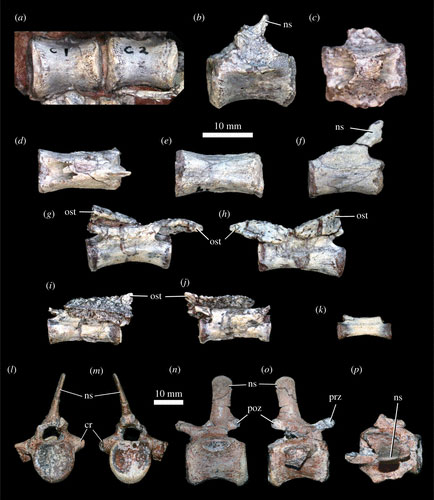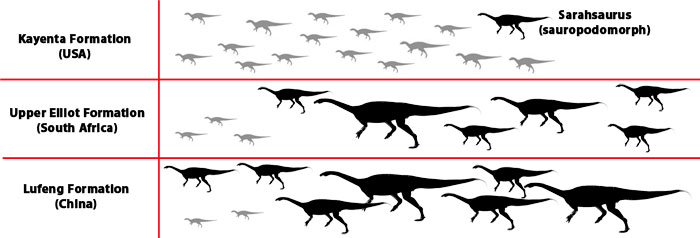Scutellosaurus Steps into the Spotlight
When asked to name an armoured dinosaur, we suspect that most readers would quickly reply with “Stegosaurus” or possibly “Ankylosaurus”. True, some armoured dinosaurs are very famous, having seeped into the public consciousness thanks to countless appearances in the media, dinosaur documentaries and films. However, very little is known about the origins of this diverse and highly successful ornithischian clade. Newly, published research on the labrador-sized early thyreophoran Scutellosaurus (S. lawleri) is helping scientists to better understand the evolutionary origin of these dinosaurs.

A Palaeontological Project Lasting Sixteen Years
The scientific paper, the first detailed anatomical assessment of Scutellosaurus covering its entire skeleton, has been published in the on-line, open access journal Royal Society Publishing. The dedicated research team consisted of PhD student Benjamin Breeden (University of Utah), Professor Richard Butler (University of Birmingham), Professor Timothy Rowe (University of Texas at Austin) along with PhD student Tom Raven and Dr Susannah Maidment (Natural History Museum, London).
This research project was first proposed back in 2005. Sixteen years after the project’s inception, the paper has been published providing a new perspective on the evolution of the armoured dinosaurs.

Scutellosaurus lawleri
Named and described in 1981, from material discovered ten years earlier. Scutellosaurus lawleri fossils come from the Kayenta Formation of Arizona, more specifically mudstones associated with the “middle third” of this Formation (Lower Jurassic). It has been estimated that the Scutellosaurus fossils are around 181 to 186 million years old (Pliensbachian and Toarcian stages).
More than seventy Scutellosaurus specimens are known, representing all parts of the skeleton. As such, Scutellosaurus fossil material is much more abundant than that of other early armoured dinosaurs such as Scelidosaurus (S. harrisoni), which was named and described by the famous Victorian anatomist Richard Owen. This relative abundance of fossil material in comparison with other early armoured dinosaurs makes Scutellosaurus an ideal candidate to help palaeontologists to better understand the evolution of this important group of plant-eating dinosaurs.

Scutellosaurus was a Biped
One of the key findings of this research is that based on limb proportions and postcranial skeletal assessments, Scutellosaurus was bipedal. As such, it is the only bipedal thyreophoran known to science. It had been suggested that as thyreophorans evolved into larger and more heavily armoured forms they lost this ability to adopt a bipedal posture.
Although the exact layout of the dermal armour of Scutellosaurus is not known, the researchers tested the hypothesis that heavier armour led these dinosaurs to adopt a quadrupedal stance.
The research team calculated the centre of mass of Scutellosaurus with its armour, without armour, with the armour of Stegosaurus and with the armour of the Late Cretaceous ankylosaurid Euoplocephalus. They found that the addition of armour did cause the centre of mass to move slightly further back in the body in all the tests. However, the team concluded that the evolution of armour probably was not the reason to cause early armoured dinosaurs to adopt quadrupedal locomotion.
More derived taxa of armoured dinosaurs required forelimb support for their body weight for other, as yet not understood reasons.
Armoured Dinosaurs Grew Slowly
Detailed analysis of Scutellosaurus bones indicate that this dinosaur grew very slowly throughout its life. This supports other studies that suggest that thyreophorans had lower metabolic rates when compared to other dinosaurs, even closely related ornithischians.
Lots of Variety in Early Jurassic Dinosaur Faunas
The supercontinent Pangaea did begin to break-up during the Jurassic, but at the time Scutellosaurus roamed what was to become the western United States, this landmass was largely intact, which in theory would have helped homologous populations of dinosaurs to evolve. That is to say, that given the absence of any geographical barriers preventing movement, similar dinosaur faunas would have existed across Pangaea. When this study of Scutellosaurus is looked at from the wider perspective of dinosaur evolution and radiation, a different picture emerges.
The ornithischian dinosaurs from the Kayenta Formation are represented by Scutellosaurus lawleri, a larger unnamed thyreophoran known from isolated bones and an undescribed hetrodontosaurid. Scutellosaurus fossils are the most abundant dinosaur fossils associated with the Kayenta Formation, they are much more common than theropod or sauropodomorph fossils. In contrast, the roughly contemporaneous upper Elliot Formation of South Africa has many more sauropodomorphs than ornithischians and the dinosaur biota of the Lufeng Formation of China is dominated by sauropodomorphs with ornithischian material exceptionally rare.

This suggests that there was considerable variation in the composition of dinosaur biotas during the Early Jurassic.
The scientific paper: “The anatomy and palaeobiology of the early armoured dinosaur Scutellosaurus lawleri (Ornithischia: Thyreophora) from the Kayenta Formation (Lower Jurassic) of Arizona” by Benjamin T. Breeden, Thomas J. Raven, Richard J. Butler, Timothy B. Rowe and Susannah C. R. Maidment published by Royal Society Publishing.
Visit the Everything Dinosaur website: Everything Dinosaur.

